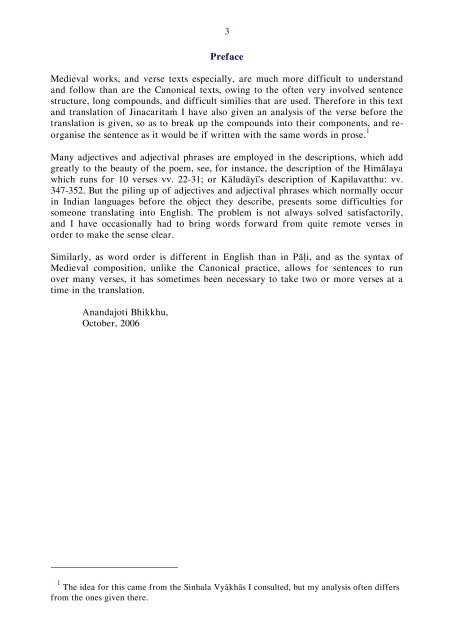Jinacaritaṁ: The Life of the Victorious Buddha
A Pāli and English line by line (interlinear) version of this Medieval verse biography of the Buddha from his Bodhisatta aspiration to the founding of the Jetavana monastery (together with extensive annotation).
A Pāli and English line by line (interlinear) version of this Medieval verse biography of the Buddha from his Bodhisatta aspiration to the founding of the Jetavana monastery (together with extensive annotation).
Create successful ePaper yourself
Turn your PDF publications into a flip-book with our unique Google optimized e-Paper software.
3<br />
Preface<br />
Medieval works, and verse texts especially, are much more difficult to understand<br />
and follow than are <strong>the</strong> Canonical texts, owing to <strong>the</strong> <strong>of</strong>ten very involved sentence<br />
structure, long compounds, and difficult similies that are used. <strong>The</strong>refore in this text<br />
and translation <strong>of</strong> <strong>Jinacaritaṁ</strong> I have also given an analysis <strong>of</strong> <strong>the</strong> verse before <strong>the</strong><br />
translation is given, so as to break up <strong>the</strong> compounds into <strong>the</strong>ir components, and reorganise<br />
<strong>the</strong> sentence as it would be if written with <strong>the</strong> same words in prose. 1<br />
Many adjectives and adjectival phrases are employed in <strong>the</strong> descriptions, which add<br />
greatly to <strong>the</strong> beauty <strong>of</strong> <strong>the</strong> poem, see, for instance, <strong>the</strong> description <strong>of</strong> <strong>the</strong> Himālaya<br />
which runs for 10 verses vv. 22-31; or Kāludāyī’s description <strong>of</strong> Kapilavatthu: vv.<br />
347-352. But <strong>the</strong> piling up <strong>of</strong> adjectives and adjectival phrases which normally occur<br />
in Indian languages before <strong>the</strong> object <strong>the</strong>y describe, presents some difficulties for<br />
someone translating into English. <strong>The</strong> problem is not always solved satisfactorily,<br />
and I have occasionally had to bring words forward from quite remote verses in<br />
order to make <strong>the</strong> sense clear.<br />
Similarly, as word order is different in English than in Pāḷi, and as <strong>the</strong> syntax <strong>of</strong><br />
Medieval composition, unlike <strong>the</strong> Canonical practice, allows for sentences to run<br />
over many verses, it has sometimes been necessary to take two or more verses at a<br />
time in <strong>the</strong> translation.<br />
Anandajoti Bhikkhu,<br />
October, 2006<br />
1 <strong>The</strong> idea for this came from <strong>the</strong> Sinhala Vyākhās I consulted, but my analysis <strong>of</strong>ten differs<br />
from <strong>the</strong> ones given <strong>the</strong>re.


















